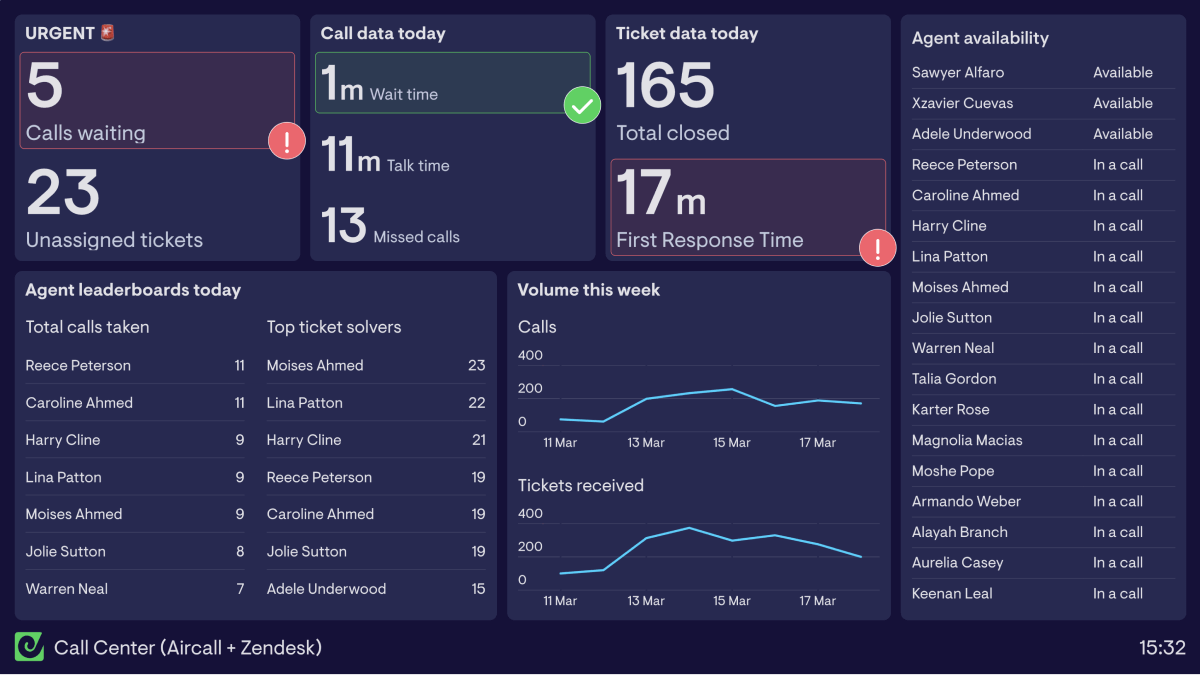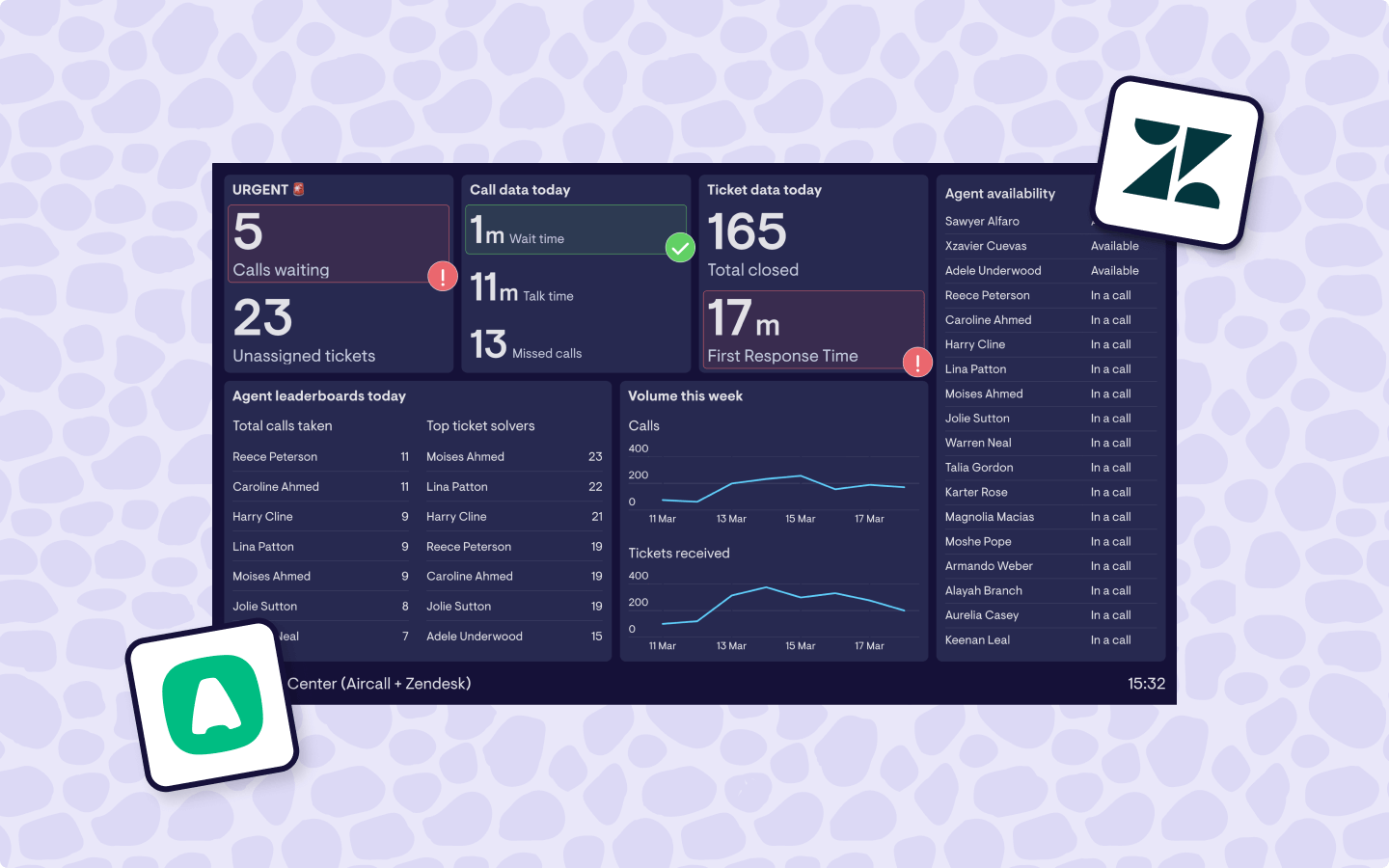If you’re a Customer Support Manager using Aircall and Zendesk together, the chances are you need to regularly access data from both platforms.
You need call metrics and ticketing metrics to monitor the performance of your team and manage workflows.
But also, and probably most importantly, you need your team to see this data. Sharing individual performance motivates them and helps to encourage friendly competition.
So can you access both in one place? Do you have to keep a ton of tabs open to track everything you need? How do you get all your most important metrics to your team in the simplest way?
The good news is, there are multiple ways to track and share data from both together. We’ll take you through three options in this post.
- Zendesk CTI Integration: best for day-to-day analysis and reporting
- Geckoboard: best for visualizing and sharing real-time KPIs
- Spreadsheets: best for deep-dive analysis and one-off reports.
Integrating Aircall data in Zendesk
How do I integrate Aircall data within Zendesk?
Using the Zendesk CTI integration you can bring data and Aircall activity into Zendesk. Agents can use the Zendesk interface to perform tasks usually undertaken in Aircall such as make, receive and synchronize calls.
All your call data is sent to Zendesk Explore when you integrate the two platforms in this way. Call information is automatically recorded by Aircall in Zendesk custom fields, allowing you to generate reports in the same way you would for your Zendesk data.
So what are the pros and cons of integrating Aircall and Zendesk data together in this way to see your data in one place?
Pros
Deeper analysis
When you’re able to build reports with Zendesk Explore you can do a deep dive on all the data living there. Meaning you’ll be able to produce detailed reports for data from both Aircall and your Zendesk platform(s) in one place.
Gives managers a big picture
Zendesk Explore is great for managers to get a true picture of workload and performance over extended periods of time. Allowing you to streamline processes and focus on the best approaches to deliver optimal customer service.
You can have hourly data available in Zendesk
If you’re on a Zendesk Professional or Enterprise plan then your data in Explore will update hourly. Otherwise it’ll be daily.
Cons
Not all Aircall data is available
You won’t be able to access the full suite of Aircall data within Zendesk Explore, so there will still be times when you’ll need to use both tools to complete reports.
Hard to share data
Though some data is available to agents within Zendesk, using Explore is often required to get access to important KPIs for your team. Most agents don’t have time to work within Explore to find the data they need and managers don’t want to share access to their reports in Explore with everyone.
Coupled with the hefty price tags for increasing user access, the option to view data in Explore isn’t ideal if you’d like to share limited, key information far and wide.
Data isn’t real-time
Even on the higher priced Zendesk plans, the data you’ll be seeing in Explore updates hourly. If you’re working in a call center environment, this isn’t real-time enough for your team to react fast.
Call data within Zendesk Explore is only included for calls that have finished, you won’t be able to access anything for active calls.
Hard to share on a TV
It’s absolutely possible to share your Zendesk Explore reports on a TV screen but it hasn’t been designed for this so it takes a bit of maneuvering and likely requires daily setup.
Creating a dashboard with Aircall and Zendesk data [with Geckoboard]
You might consider a dashboard tool such as Geckoboard as an alternative. Particularly if your main aim is to share your KPIs with your team and you’d like to do that with a TV.

Geckoboard connects directly with your Aircall and Zendesk accounts and allows you to build professional, real-time KPI dashboards in minutes.
Let’s see the pros and cons of bringing Aircall and Zendesk data together with Geckoboard.
Pros
Visualizing KPIs from Aircall, Zendesk and 90+ other data sources
One of the big wins is that you’re able to visualize data on a professional dashboard from not only Aircall and Zendesk but over 90+ data sources such as Klaus, Salesforce, Delighted, Pipedrive, and spreadsheets.
This means your team has access to all their most important KPIs in one place, rather than multiple tabs or tools.
Real-time overview of performance
Rather than waiting for hourly or daily data from Zendesk, Geckoboard’s data updates within minutes. And in the case of some Aircall metrics, in real time.
This gives managers and the team a true picture of what is happening right now.
Designed for TV
Geckoboard dashboards have been designed with TV screens in mind. So your most important call center metrics will be clear and easy to understand when shared on a TV in your office.
It’s simple to set up and will run automatically on a TV screen once connected, no need to do it yourself each day.
Sharing alerts and automated screenshots via Slack and email
If you have team members working remotely, it’s not all about TV. Geckoboard allows you to use KPI notifications to trigger alerts in Slack for changes to a specific metric e.g. more than 3 calls missed.
Alongside this, you can schedule regular dashboard snapshots to be sent via email and Slack. These are perfect for delivering an overview of performance on a daily, weekly and monthly basis.
Cons
Unable to do deeper analysis
Unlike Explore and spreadsheets, Geckoboard has not been designed with detailed analysis in mind. You won’t be able to combine data from the two sources in the way you could with a spreadsheet and it’s not set up for detailed historic analysis.
However, if you spot something strange in your live data Interactive View is available to use with both Zendesk and Aircall to quickly interpret the data behind the scenes.
Pulling Aircall and Zendesk data into a spreadsheet
Finally, perhaps pulling data into a spreadsheet is a good idea. This would allow you to do some of that deeper analysis and also share with your team. Everyone can access a spreadsheet for free after all.
How do you bring Aircall and Zendesk data into a spreadsheet?
There are a few options here but the most obvious two are the ones we’ll focus on.
First is by manually adding data to a spreadsheet. You can export csv files from both Zendesk and Aircall to run your own analysis on the data side by side.
Second is using an automation tool (such as Zapier) to set up connections between each platform and a spreadsheet. This takes the manual work out of getting the data into the spreadsheet.
But in both cases, you’ll still need to work on analyzing, and if you’re sharing the data, presenting it in a readable format.
Let’s take a look at the pros and cons of this approach.
Pros
Accessibility
The ideal thing about a spreadsheet is that they are accessible to everyone. You don’t need to add additional users/accounts and the vast majority of people are familiar with spreadsheets.
Deeper analysis
Like Zendesk Explore, spreadsheets are great for deeper analysis of your data. The options for working with data in a spreadsheet are almost limitless. If you’re a dab hand with formulae then you could easily gather rich analysis within a spreadsheet.
Cons
Manual input
If you need to input your data manually then this is labor intensive compared to the other options in this post. Alongside the extra work entailed, you’ll always be viewing data that is out of date.
Visualizing data
Spreadsheets tend to get overcrowded very quickly. It’s absolutely possible to streamline them and create a version of a spreadsheet dashboard but this is not what they were designed to do so it’s not the strongest way of presenting data in a clear and visual way.
Clear communication
Aside from the visualization of your data, spreadsheets can be noisy. The more data included tends to make it harder for you to communicate the most important pieces to your team.
Hard to share on a TV
Again, like Explore, spreadsheets haven't been designed with sharing data on a TV screen. It’s possible but it’s unlikely to have a clear and professional finish that you’d expect in an environment like a call center
Want to bring your data from Aircall and Zendesk together with Geckoboard? Give it a try with a 14-day free trial.

